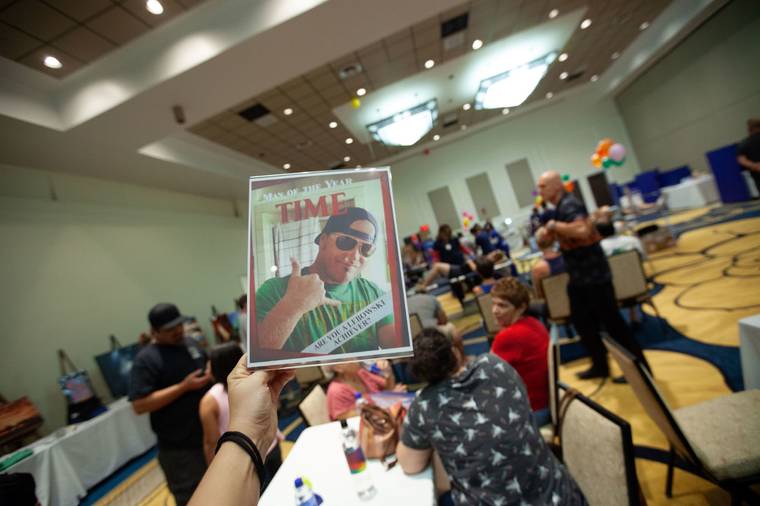KAILUA-KONA — Three years in, organizers behind the Elvis Sheppard Blood Drive, which is already the largest blood drive in Hawaii County, are aiming higher.
They want it to the biggest in the state.
“The truth is that blood cannot be made outside of the human body, so you’re an actual real-life superhero,” said Jen Davis, co-founder of the EAS Abide Initiative. “Your one blood donation can turn into the opportunity to save three different lives.”
With her co-founder Anne Broderson, they’ve set a goal of getting 200 donors to come out for event number three, which is slated for July 3 at the Sheraton Kona Resort and Spa at Keauhou Bay. Over the past two years, Broderson said, the initiative’s blood drives have raised more than $25,000 to support trauma services and brought out at least 321 donors.
“And then if you figure every one of those people can save three lives with their donation, then we’re at well over a thousand people that we’ve saved in Hawaii,” said Broderson, a nurse practitioner at Alii Health.
Davis and Broderson started the initiative after the death of Davis’ fiance, Elvis Sheppard, who died after he was hit by a vehicle while riding his motorcycle on Hina Lani Street in April 2017. That July, Broderson, who cared for Sheppard the night of the crash as a nurse at Kona Community Hospital, together with Davis organized the first Elvis Sheppard Blood Drive.
Next month’s blood drive is scheduled from 9 a.m. to 7 p.m. at the Sheraton’s convention center ballroom.
There are 350 appointment slots available and Broderson said they’ve had 189 donors signed up so far.
Appointments are recommended, and can be booked by call 326-7836 or emailing heart@islandcpr.com.
Donors, according to the Blood Bank of Hawaii, must be at least 16 years old, weigh at least 110 pounds, be in good health and have a photo ID that shows a date of birth. Those who are 16 or 17 also must have a signed Blood Bank of Hawaii parent/guardian consent form.
That form, along with a full table of additional requirements, is available at www.bbh.org by clicking “Who can donate” under the “Become a donor” tab.
Davis said they’re working hard to fill as many of the slots as they can as not everyone who signs up will ultimately be eligible to donate blood.
In the past, the event has brought out many first-time donors.
“Typically our drive has brought in a hundred-plus first-time donors every year,” Broderson said, “which is awesome because then we’re hoping that those people go on to become regular blood donors.”
The event will also feature a “Whole Family Wellness Fair,” including representatives from Island CPR offering CPR education and from Kona Community Hospital promoting the Stop the Bleed campaign, which works to train members of the public on how they can help in a bleeding emergency before medics arrive.
There will also be opportunities for people to donate to fundraising efforts by the Kona Hospital Foundation with the money earmarked for supporting trauma services. Davis said the money raised will be focused on an in-depth bereavement program.
After Sheppard’s death, she said, there wasn’t much education or opportunity for people to help her know what to do after such a tragic event.
“After you lose somebody, you just don’t know what to do with yourself,” she said. “And so having something set up at the hospital with a bereavement program — where to go, what to do, how to do it and the support — immediately following that loss is what we’re trying to focus on.”
For those who aren’t eligible to donate blood, Davis encouraged them to bring family or friends who can donate, emphasizing the importance of making it an event for the whole community.
“So even if at the event you’re not able to donate, bring somebody who might be able to or show up for the educational portion of it,” Davis said.
And for those who have donated to the cause, Davis said, they ultimately “feel really good about it.”
“It’s an hour out of their lives to really save individuals within the community that they probably will know at some point,” she said. “We live in such a small place that it’s not if your ohana will need it, it’s kind of when your ohana will need it. So really ultimately the bottom line is you feel good about yourself and you’re actually saving lives within your own community.”



